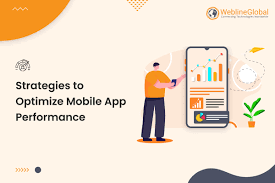Notifications

7 minutes, 42 seconds
-37 Views 0 Comments 0 Likes 0 Reviews

Mobile apps today are more than just digital tools—they’re essential to how we communicate, shop, entertain, and work. With AI becoming an integral part of mobile experiences—powering everything from personalized recommendations to voice assistants—the demand for seamless performance has only increased. But one of the biggest challenges developers face is making sure these apps run smoothly across a wide range of devices.
From older Android phones to the latest iPhones, your users expect fast load times, glitch-free navigation, and consistent functionality. And if your app fails to meet those expectations? Users will abandon it—fast.
In this article, we’ll break down how to optimize your mobile app performance across devices, ensuring a consistent and delightful experience for every user, every time.
Why Cross-Device Performance Matters
There are thousands of different mobile devices on the market, each with unique screen sizes, hardware capabilities, OS versions, and network conditions. Whether your app is built for Android, iOS, or both, performance issues on even a small segment of devices can damage your brand and result in poor retention.
. A well-optimized mobile app is one that:
. Loads quickly and responds instantly
. Performs smoothly across screen sizes and resolutions
. Conserves battery and memory
. Works under varying network conditions
1. Build a Lightweight App Architecture
Start with the right foundation. Your app’s architecture should be modular and lightweight to improve maintainability and scalability. Avoid monolithic codebases and instead embrace clean code principles and component-based architectures like MVVM, MVC, or MVP.
Key Tips:
. Break features into reusable components
. Keep business logic separated from the UI
. Optimize API calls and reduce redundant data loading
2. Use Adaptive Layouts and Responsive Design
To handle the wide variety of screen sizes, use adaptive layouts that adjust dynamically.
Android:
Use ConstraintLayout, Jetpack Compose, and Density-independent pixels (dp) to create scalable designs.
iOS:
Use Auto Layout with Size Classes and SwiftUI to handle screen adjustments efficiently.
Ensure that:
. Buttons and text fields don’t get cut off
. Layouts work in both portrait and landscape
. UI elements resize properly on tablets and small phones
3. Optimize Graphics and Media Assets
Heavy images and videos can slow down your app and increase loading times.
Best Practices:
. Use vector graphics (SVGs, PDFs) where possible
. Compress images using tools like TinyPNG or WebP
. Implement lazy loading for off-screen content
. Choose appropriate image resolutions for different devices
Also, avoid using high-resolution assets on low-end devices. Serve media based on device capabilities.
4. Implement Efficient Memory Management
Memory leaks can destroy your app’s performance. Use profiling tools to identify memory-heavy components and clean them up efficiently.
Tools to Use:
. Android Studio Profiler
. Xcode Instruments (Leaks, Allocations)
. LeakCanary (for Android)
. Instruments with SwiftUI (for iOS)
Use weak references where needed, clear unused variables, and avoid loading large datasets into memory all at once.
5. Minimize Network Requests and Optimize APIs
Network calls are one of the slowest parts of your app. They affect load time and responsiveness, especially on slower connections.
Tips:
. Batch requests when possible
. Implement caching mechanisms (like Retrofit + Room or Apollo + SQLite)
. Use pagination for long lists
. Opt for compressed data formats like GZIP or Protobuf
Always test API performance under real-world network conditions—3G, 4G, WiFi, and even offline.
6. Reduce App Startup Time
The first impression counts. Users expect your app to launch within 1–2 seconds.
Strategies:
. Delay non-essential operations until after the UI is rendered
. Use splash screens to mask loading
. Optimize cold vs. warm start behavior
. Use lightweight services during app launch
7. Optimize for Battery and CPU Usage
High battery drain and CPU usage can cause users to uninstall your app. Monitor your app’s background processes and eliminate unnecessary tasks.
Optimization Ideas:
. Limit background refreshes
. Avoid unnecessary GPS/polling
. Use JobScheduler or WorkManager on Android
. Use Background App Refresh sparingly on iOS
8. Use Performance Monitoring Tools
Continuous monitoring is key to long-term optimization. There are plenty of tools to help track issues across devices.
Monitoring Tools:
Firebase Performance Monitoring
. Crashlytics
. Sentry
. AppDynamics
. New Relic Mobile
These tools help you analyze performance across real devices, OS versions, and usage scenarios, identifying lags, crashes, and bottlenecks.
9. Run Extensive Device and OS Testing
Don’t just test on one or two phones. Use emulators, simulators, and real device labs to test across different environments.
Testing Services:
. BrowserStack
. Sauce Labs
. Firebase Test Lab
. Kobiton
Test for:
. UI responsiveness
. Network behavior
. Battery consumption
. Multitasking scenarios
Also, remember to test across multiple OS versions—especially older Android devices and various iOS releases.
10. Update Regularly and Keep Libraries Up-to-Date
Outdated libraries or SDKs can introduce security flaws and performance issues. Always keep dependencies updated, and remove any unused SDKs.
When updating, review changelogs for performance improvements or breaking changes that could affect older devices.
Conclusion: Performance Is a Feature, Not an Afterthought
In today’s hyper-competitive mobile landscape, performance is one of the most important features your app can offer. Users expect seamless, fast, and smooth experiences—no matter what device they’re using.
By building efficient architecture, leveraging responsive design, managing memory and network usage, and testing rigorously, you can ensure your app delivers exceptional performance across devices.
About Apptunix
At Apptunix, we specialize in building high-performance mobile apps that look great and run even better—on every device. Our developers leverage the latest tools, frameworks, and performance optimization strategies to make sure your app delivers an unmatched user experience.
🚀 Want to build a lightning-fast app that works flawlessly across all devices?
👉 Let’s chat! Visit www.apptunix.com to schedule a free consultation.
mobile app development mobile apps #technology #AIInnovation

